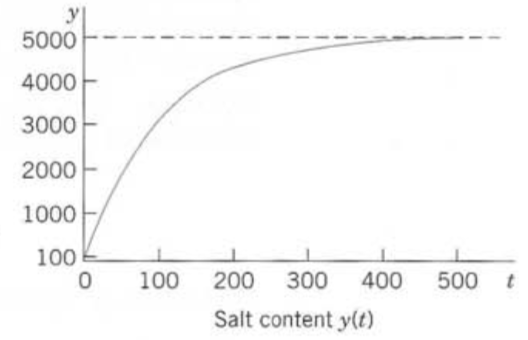
Mixing problems occur quite frequently in chemical industry. We explain here how to solve the basic model involving a single tank (see the figure on the right). The tank contains 1000 gal of water in which initially 100 lb of salt is dissolved. Brine runs in at a rate of 10 gal/min, and each gallon contains 5 lb of dissolved salt. The mixture in the tank is kept uniform by stirring. Brine runs out at 10 gal/min.

Find the amount of salt in the tank at any time t.
Let y(t) denote the amount of salt in the tank at time t. Its time rate of change is
 |
(1) |
5 lb times 10 gal gives an inflow of 50 lb of salt. Now, the outflow is 10 gal of brine. This is 10/1000=0.01 (=1%) of the total brine content in the tank, hence 0.01 of the salt content y(t), that is, 0.01y(t). Thus, from (1) we obtain the following ODE as a model:
 . . |
(2) |
The ODE (2) is separable. Separation, integration, and taking exponents on both sides gives
 , ,  , ,  .
. |
Initially, the tank contains 100 lb of salt. Hence y(0)=100 is the initial condition that will give the unique solution. Substituting y=100 and t=0 in the last equation gives 100-5000=ce0=c. Hence c=4900. Hence the amount of salt in the tank at time t is
 . . |
(3) |
This function (see the graph on the right) shows an exponential approach to the limit 5000 lb. Can you explain physically that y(t) should increase with time? That its limit is 5000 lb. Can you see the limit directly from the ODE?
